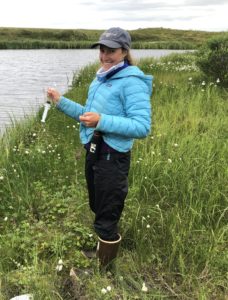 When we arrived at our field camp in the Yukon Kuskokwim Delta last week, the term “fen” had been something I had only encountered in papers. After five days spent in and around fens, I have a new appreciation for this feature of the landscape that bridges the gap between terrestrial and aquatic ecosystems.
When we arrived at our field camp in the Yukon Kuskokwim Delta last week, the term “fen” had been something I had only encountered in papers. After five days spent in and around fens, I have a new appreciation for this feature of the landscape that bridges the gap between terrestrial and aquatic ecosystems.
For my Polaris research project, I am studying plant-mediated methane flux in burned and unburned fens. Flux is basically the rate of greenhouse gas released from a known area over time. Some plants have hollow stems that forge a direct link between soil and atmosphere, which facilitates the movement of methane that is produced in soil to the atmosphere. Methane gas contributes strongly to climate change and global warming, though it is often not considered as much as carbon dioxide.
I am interested in looking at methane because in this landscape, you can step in a fen and see bubbles of gas (most likely methane) bubble to the surface as a result of your disturbance of the bottom. Seeing this effect is a good reminder that we are always changing the landscapes we are a part of and understanding how our climate is changing is an important and daunting task.
In order to look at the ability of plants to facilitate this gas exchange, I am comparing methane release from intact plants, plants that have been cut down near the soil, and plants that have been cut and covered with vaseline. These experimental manipulations allow me to determine if plants act as mediators of atmospheric methane release as well as whether or not blocking photosynthesis (by cutting the plant) blocks the plant’s ability to act as a straw. I am specifically looking at methane flux from cotton grass, an abundant tundra plant that has reminded many of us of the truffula trees in Dr. Seuss’s “Lorax.”
By conducting flux experiments on the same species of plant (cotton grass) in burned and unburned fens I am also able to compare how tundra fires may influence plant-mediated methane flux. When fire burns organic matter is combusted and breaks down, releasing nutrients in forms more easily accessible to plants. Runoff after a fire can also carry organic matter and nutrients into fens. I hypothesize that increased nitrogen input to fens after the burn could affect plant growth by acting as a key nutrient that allows them to grow deeper / larger roots and thus have greater access to methane at deeper depths and act as better straws thus releasing more methane into the atmosphere. Burns could also change the water chemistry of a fen in other ways that may impact the plants growing in that fen and their ability to facilitate the release of methane into the atmosphere.
Because we are lucky enough to have access to helicopters, as well, I am also including a broader component to my project. On helicopter days, I will be visiting fens in burned and unburned areas at a greater distance from our camp in order to try to classify the dominant vegetation in a fen and correlate it with GPS coordinates to try and map species dominance across different fens. I will also be taking aquatic samples in these fens to look at how plant dominance in fens effects methane concentration in groundwater.
I’m still blown away by the fact that for two weeks our main priorities are asking lots of questions and conducting research projects in this incredible place with incredible people. Field work is not always easy, but I love coming back after a long day and seeing the excitement on other student’s faces as they describe the data they collected, share an idea they had for another layer of their project, or show us a picture of an interesting feature of the landscape they found while out for the day. It’s been fun to see both myself and the other new students this year gain momentum on our projects and confidence in our scientific ability. I can’t wait to see where we all are at the end of two weeks in the tundra.
— Anneka Williams is a student at Bowdoin College



